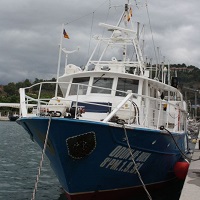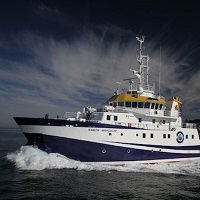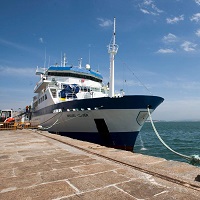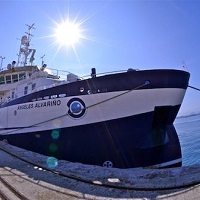Keyword
Carbon concentrations in sediment
18 record(s)
Type of resources
Categories
Topics
INSPIRE themes
Keywords
Contact for the resource
Provided by
Years
Formats
Status
-

The aim of this cruise was to collect surficial sediments from different areas of the Mediterranean Spanish coast for studying the spatial and temporal trends of persistent organic pollutants (organochlorinted pollutants, trace metals and aromatic hydrocarbons) and metal contamination in this environmental matrix. This cruise was included in the activities of the project 2-ESMARME from the IEO (Spanish Oceanographic Institute). This project gives fulfillment to the Annex II of the mission of management of the Ministry of Environment and Rural and Marine Affairs to the IEO on scientific and technical assistance related to the monitoring of the marine contamination and biological effects in the Mediterranean coast of Spain, within the framework of the Barcelona Convention for the protection of the marine environment and the coastal Region of the Mediterranean Sea.
-
The Western Iberian Margin (WIM) the area of interest for this cruise is located at the slope of the Southwest coast of Portugal (depths from 200 to 800 meters), where otter trawling is occurring on a continuous base, targeting Norway lobster (Nephrops norvegicus). The area includes fishing grounds with different levels of impact (from no fishing to intense trawling and fixed nets). We identified three main objectives for this sampling campaign: 1) Identify areas of high and low fishing intensity by means of side scan sonar and ROV exploration 2) Sample different areas/depths between 200 and 1000 m water depth for benthos with box corer and multiple corer 3) Collect sediments from the fished and the non‐fished site with box corer or multiple corer for onboard experiments in which different measures of ecosystem functioning will be measured 4) Collect colonization trays at food fall site with the ROV (uAveiro)
-

The objective of this campaign is the sampling of sediments. These sediments will be used to assess the organic and inorganic pollutants in the marine area, as well as the possible biological effects of contaminants. In this survey, along with the traditional pollutants, the presence of microplastics in sediments will also be evaluated.
-

Analyze and evaluate the environmental impact on the coastal area of Gibraltar caused by the dumping of concrete and rock blocks into the sea.
-

Training of students of the Master of Marine Sciences: Oceanography and Marine Environment Management of the University of Barcelona.
-

Evaluate transport of water salinity, temperature, carbon and other variables of the greenhouse
-
NA
-

The objective of the DOS MARES project is twofold. First, we aim at understanding the effects of the atmospheric teleconnections between the Cantabrian Sea and the north-western Mediterranean Sea, and their impacts on the deep ecosystem, both pelagic and benthic. Second, we want to know in which way the transfer of the signal from the external forcings towards the deep ecosystem controls the community structure and the population dynamics. Thus, in March 2012 we deployed 6 mooring lines equipped with sediment traps and currentmeters in the Avilés and Gaviera canyons and the slope. In September 2012 the moorings were successfully recovered and redeployed again, and during this cruise DOSMARES BIOCANT3 they have been finally recovered and the 1-year monitoring effort finalised. In addition, CTD profiling has been performed to characterise the biological and physical structure of the water column (including the acquisition of discrete water samples), multicorers have been obtained to characterise the geochemical properties of surface sediments, and a multinet used to obtain macro- and meso-zooplankton community structure. Overall, data will allow to characterize the external forcings and abiotic conditions in the Cantabrian Sea, and thus establish the links between abiotic conditions, populations and pelagic and benthopelagic resources.
-

The objective of the DOS MARES project is twofold. First, we aim at understanding the effects of the atmospheric teleconnections between the Cantabrian Sea and the north-western Mediterranean Sea, and their impacts on the deep ecosystem, both pelagic and benthic. Second, we want to know in which way the transfer of the signal from the external forcings towards the deep ecosystem controls the community structure and the population dynamics. Thus, in March 2012 we deployed 6 mooring lines equipped with sediment traps and currentmeters in the Avilés and Gaviera canyons and the slope. In September 2012 the moorings were successfully recovered and redeployed again, and during this cruise DOSMARES BIOCANT3 they have been finally recovered and the 1-year monitoring effort finalised. In addition, CTD profiling has been performed to characterise the biological and physical structure of the water column (including the acquisition of discrete water samples), multicorers have been obtained to characterise the geochemical properties of surface sediments, and a multinet used to obtain macro- and meso-zooplankton community structure. Overall, data will allow to characterize the external forcings and abiotic conditions in the Cantabrian Sea, and thus establish the links between abiotic conditions, populations and pelagic and benthopelagic resources.
-

The main target of the NUREIEVA-MAR-1 campaign is twofold. On the one hand, it aims to establish the geometry and the three-dimensional internal structure of the deposit of mineral discharges submerged in front of the Bay of Portmán and, on the other hand, it intends to verify the data obtained by obtaining witnesses from the deposit. During the campaign, a high resolution multibeam bathymetric cartography and a high density mesh of TOPAS PS18 parametric probe profiles will be carried out, and sediment tokens will be obtained by gravity or piston core grabs of the longest length possible, as well as by means of multicorer, box corer and dredge Van Veen for the upper part of the deposit. In addition, the discharge of dissolved metals from the deposit emerged at sea will be quantified using CTD profiles and sampling with hydrographic bottles. Floating microplastics will also be sampled.
 Catálogo de datos del IEO
Catálogo de datos del IEO